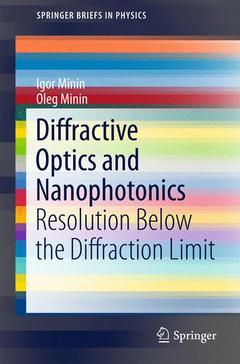Description
Diffractive Optics and Nanophotonics, 1st ed. 2016
Resolution Below the Diffraction Limit
SpringerBriefs in Physics Series
Authors: Minin Igor, Minin Oleg
Language: English
Subject for Diffractive Optics and Nanophotonics:
52.74 €
In Print (Delivery period: 15 days).
Add to cartSupport: Print on demand
Description
/li>Contents
/li>Biography
/li>Comment
/li>
In this book the authors present several examples of techniques used to overcome the Abby diffraction limit using flat and 3D diffractive optical elements, photonic crystal lenses, photonic jets, and surface plasmon diffractive optics. The structures discussed can be used in the microwave and THz range and also as scaled models for optical frequencies. Such nano-optical microlenses can be integrated, for example, into existing semiconductor heterostructure platforms for next-generation optoelectronic applications.
Chapter 1 considers flat diffractive lenses and innovative 3D radiating structures including a conical millimeter-wave Fresnel zone plate (FZP) lens proposed for subwavelength focusing. In chapter 2 the subwavelength focusing properties of diffractive photonic crystal lenses are considered and it is shown that at least three different types of photonic crystal lens are possible.
With the aim of achieving subwavelength focusing, in chapter 3 an alternative mechanism to produce photonic jets at Terahertz frequencies (terajets) using 3D dielectric particles of arbitrary size (cuboids) is considered. A scheme to create a 2D ?teraknife? using dielectric rods is also discussed. In the final chapter the successful adaptation of free-space 3D binary phase-reversal conical FZPs for operation on surface plasmon-polariton (SPP) waves demonstrates that analogues of Fourier diffractive components can be developed for in-plane SPP 3D optics.
Review
ing theory, modelling and experiment, this book will be a valuable resource for students and researchers working on nanophotonics and sub-wavelength focusing and imaging.Igor V. Minin receivedM.S. in Physics, Novosibirsk State University, Russia (1982) and the Ph.D. degree in radio-physics including quantum physics from the Leningrad Electro-Technical University, Russia, in 1986 and the D.Sc. degree in calculation experiment technology and microwave antennas from the Novosibirsk State Technical University, Russia, in 2004.
He worked as a Visiting Researcher at the DaimlerChrysler AG, Germany, Harbin Institute of Technology, China and Samsung Electronics, Korea. He has been an Invited Lecturer at several universities and institutions, co-chairman of several IEEE conferences and symposiums. He was with the Novosibirsk State Technical University, Russia from 2001 to 2006, as a Full Professor at the Department of Information Protection. Now Igor Minin is a full professor with the Siberian State Academy of Geodesy, Russia.
Minin I.V. is a Federal expert of the Russian Government committee in the scientific field (2014-to present).
Oleg V. Minin receivedM.S. in Physics, Novosibirsk State University, Russia (1982) and the Ph.D. degree in radio-physics including quantum physics from the Institute of Atmosphere Optics, Tomsk, Russia, in 1986 and the D.Sc. degree in optics and microwave antennas from the Novosibirsk State Technical University, Russia, in 2004. He worked as a Visiting Researcher at the DaimlerChrysler AG, Germany, Harbin Institut
e of Technology, China and Samsung Electronics, Korea. He has been an Invited Lecturer at several universities and institutions, co-chairman of several IEEE conferences and symposiums. He was with the Novosibirsk State Technical University, Russia from 2001 to 2006, as a Full Professor at the Department of Information Protection.In the field of diffractive optics of millimeter/THz wave Professors I.Minin and O.Minin achieved a number of pioneering results. They are the world leading authority on arbitrary 3D diffractive focusing elemen
These books may interest you

Diffractive Nanophotonics 56.31 €

Diffractive Nanophotonics 220.72 €

Diffractive Optics and Nanophotonics 220.72 €

